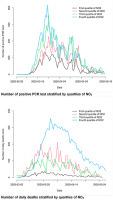Environmental Research ( IF 7.7 ) Pub Date : 2020-09-12 , DOI: 10.1016/j.envres.2020.110177 Marc Saez 1 , Aurelio Tobias 2 , Maria A Barceló 1

|
Background
The risk of infection and death by COVID-19 could be associated with a heterogeneous distribution at a small area level of environmental, socioeconomic and demographic factors. Our objective was to investigate, at a small area level, whether long-term exposure to air pollutants increased the risk of COVID-19 incidence and death in Catalonia, Spain, controlling for socioeconomic and demographic factors.
Methods
We used a mixed longitudinal ecological design with the study population consisting of small areas in Catalonia for the period February 25 to May 16, 2020. We estimated Generalized Linear Mixed models in which we controlled for a wide range of observed and unobserved confounders as well as spatial and temporal dependence.
Results
We have found that long-term exposure to nitrogen dioxide (NO2) and, to a lesser extent, to coarse particles (PM10) have been independent predictors of the spatial spread of COVID-19. For every 1 μm/m3 above the mean the risk of a positive test case increased by 2.7% (95% credibility interval, ICr: 0.8%, 4.7%) for NO2 and 3.0% (95% ICr: -1.4%,7.44%) for PM10. Regions with levels of NO2 exposure in the third and fourth quartile had 28.8% and 35.7% greater risk of a death, respectively, than regions located in the first two quartiles.
Conclusion
Although it is possible that there are biological mechanisms that explain, at least partially, the association between long-term exposure to air pollutants and COVID-19, we hypothesize that the spatial spread of COVID-19 in Catalonia is attributed to the different ease with which some people, the hosts of the virus, have infected others. That facility depends on the heterogeneous distribution at a small area level of variables such as population density, poor housing and the mobility of its residents, for which exposure to pollutants has been a surrogate.
中文翻译:

长期接触空气污染物对西班牙加泰罗尼亚 COVID-19 空间传播的影响。
背景
COVID-19 感染和死亡的风险可能与环境、社会经济和人口因素的小区域分布不均匀有关。我们的目标是在小范围内调查长期暴露于空气污染物是否会增加西班牙加泰罗尼亚 COVID-19 发病和死亡的风险,同时控制社会经济和人口因素。
方法
我们使用混合纵向生态设计,研究人群由 2020 年 2 月 25 日至 5 月 16 日期间的加泰罗尼亚小区域组成。我们估计了广义线性混合模型,其中我们控制了广泛的观察到和未观察到的混杂因素以及空间和时间依赖性。
结果
我们发现,长期接触二氧化氮 (NO 2 ) 以及在较小程度上接触粗颗粒 (PM 10 ) 是 COVID-19 空间传播的独立预测因素。对于NO 2和 3.0%(95% ICr:-1.4% , 7.44%) 用于 PM 10。NO 2暴露水平在第三和第四四分位数的地区比位于前两个四分位数的地区的死亡风险分别高出 28.8% 和 35.7%。
结论
尽管可能有生物学机制至少部分解释了长期暴露于空气污染物与 COVID-19 之间的关联,但我们假设 COVID-19 在加泰罗尼亚的空间传播归因于与有些人,病毒的宿主,已经感染了其他人。该设施依赖于小范围变量的异质分布,例如人口密度、贫困住房和居民的流动性,而这些变量暴露于污染物是一个替代指标。







































 京公网安备 11010802027423号
京公网安备 11010802027423号